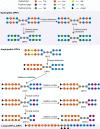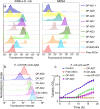Amphipathic dendritic poly-peptides carrier to deliver antisense oligonucleotides against multi-drug resistant bacteria in vitro and in vivo
- PMID: 35366899
- PMCID: PMC8977034
- DOI: 10.1186/s12951-022-01384-y
Amphipathic dendritic poly-peptides carrier to deliver antisense oligonucleotides against multi-drug resistant bacteria in vitro and in vivo
Abstract
Background: Outbreaks of infection due to multidrug-resistant (MDR) bacteria, especially Gram-negative bacteria, have become a global health issue in both hospitals and communities. Antisense oligonucleotides (ASOs) based therapeutics hold a great promise for treating infections caused by MDR bacteria. However, ASOs therapeutics are strangled because of its low cell penetration efficiency caused by the high molecular weight and hydrophilicity.
Results: Here, we designed a series of dendritic poly-peptides (DPP1 to DPP12) to encapsulate ASOs to form DSPE-mPEG2000 decorated ASOs/DPP nanoparticles (DP-AD1 to DP-AD12) and observed that amphipathic DP-AD2, 3, 7 or 8 with a positive charge ≥ 8 showed great efficiency to deliver ASOs into bacteria, but only the two histidine residues contained DP-AD7 and DP-AD8 significantly inhibited the bacterial growth and the targeted gene expression of tested bacteria in vitro. DP-AD7anti-acpP remarkably increased the survival rate of septic mice infected by ESBLs-E. coli, exhibiting strong antibacterial effects in vivo.
Conclusions: For the first time, we designed DPP as a potent carrier to deliver ASOs for combating MDR bacteria and demonstrated the essential features, namely, amphipathicity, 8-10 positive charges, and 2 histidine residues, that are required for efficient DPP based delivery, and provide a novel approach for the development and research of the antisense antibacterial strategy.
Keywords: Antibacterial strategy; Antisense; Delivery; Dendritic poly-peptides; Multidrug-resistant bacteria; Nanoparticles; Oligonucleotide.
© 2022. The Author(s).
Conflict of interest statement
All authors declare that they have no competing interests.
Figures






Similar articles
-
Efficient Delivery of Antisense Oligonucleotides by an Amphipathic Cell-Penetrating Peptide in Acinetobacter baumannii.Curr Drug Deliv. 2019;16(8):728-736. doi: 10.2174/1567201816666190627141931. Curr Drug Deliv. 2019. PMID: 31244437
-
Advances in the delivery of antisense oligonucleotides for combating bacterial infectious diseases.Nanomedicine. 2018 Apr;14(3):745-758. doi: 10.1016/j.nano.2017.12.026. Epub 2018 Jan 16. Nanomedicine. 2018. PMID: 29341934 Review.
-
Antisense Oligonucleotides Selectively Enter Human-Derived Antibiotic-Resistant Bacteria through Bacterial-Specific ATP-Binding Cassette Sugar Transporter.Adv Mater. 2023 Jul;35(28):e2300477. doi: 10.1002/adma.202300477. Epub 2023 May 26. Adv Mater. 2023. PMID: 37002615
-
Biomineralized Cascade Enzyme-Encapsulated ZIF-8 Nanoparticles Combined with Antisense Oligonucleotides for Drug-Resistant Bacteria Treatment.ACS Appl Mater Interfaces. 2022 Feb 9;14(5):6453-6464. doi: 10.1021/acsami.1c23808. Epub 2022 Jan 30. ACS Appl Mater Interfaces. 2022. PMID: 35094518
-
Antisense oligonucleotides: a promising therapeutic option against infectious diseases.Nucleosides Nucleotides Nucleic Acids. 2024;43(1):1-39. doi: 10.1080/15257770.2023.2228841. Epub 2023 Jul 3. Nucleosides Nucleotides Nucleic Acids. 2024. PMID: 37395450 Review.
Cited by
-
Applications of peptides in nanosystems for diagnosing and managing bacterial sepsis.J Biomed Sci. 2024 Apr 19;31(1):40. doi: 10.1186/s12929-024-01029-2. J Biomed Sci. 2024. PMID: 38637839 Free PMC article. Review.
-
Optimization of Dendritic Polypeptide Delivery System for Antisense Antibacterial Agents Targeting ftsZ.ACS Omega. 2024 Apr 30;9(19):20966-20975. doi: 10.1021/acsomega.4c00114. eCollection 2024 May 14. ACS Omega. 2024. PMID: 38764644 Free PMC article.
-
Promising strategies employing nucleic acids as antimicrobial drugs.Mol Ther Nucleic Acids. 2024 Jan 18;35(1):102122. doi: 10.1016/j.omtn.2024.102122. eCollection 2024 Mar 12. Mol Ther Nucleic Acids. 2024. PMID: 38333674 Free PMC article. Review.
References
MeSH terms
Substances
Grants and funding
LinkOut - more resources
Full Text Sources

